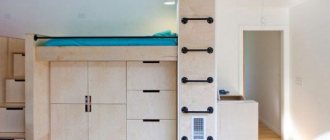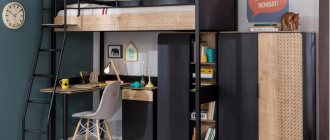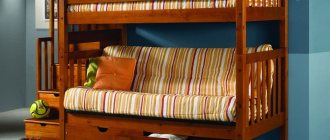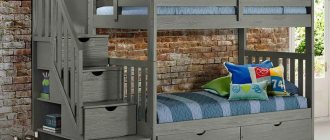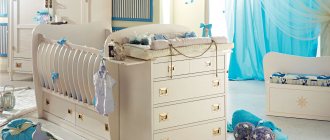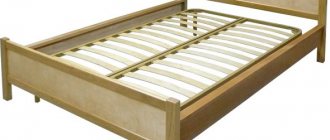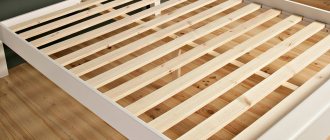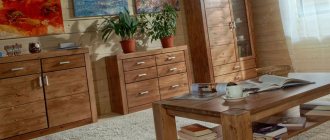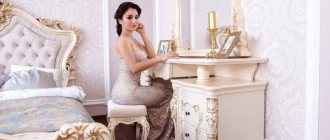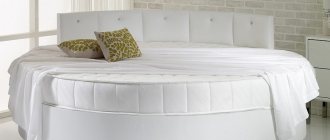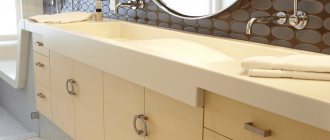1600 0 0
Icer June 26, 2018Specialization: master in the construction of plasterboard structures, finishing work and laying floor coverings. Installation of door and window units, finishing of facades, installation of electrical, plumbing and heating - I can give detailed advice on all types of work.
If the issue of saving space is acute or you don’t know how to properly arrange a guest bed in a studio apartment, then a two-level design will be an excellent solution. This option is specifically designed for adults and is of appropriate quality and durability. In this review, we will tell you about the main types of such furniture and figure out what you should pay attention to when choosing a suitable model.
Adult models of two-level beds often have an unusual design
Types of construction
To get a comfortable corner for relaxation, you need to take into account the functionality and aesthetics of the corner bunk bed design. For a successful arrangement of furniture in the general environment, you need to choose the most optimal existing model.
Here are the most popular and practical:
- a furniture complex consisting of two beds and one or a pair of work areas with a table;
- beds with a built-in wardrobe for clothes, shoes or toys;
- bed and sofa with shelves for books and board games;
- bunk design with two beds and drawers for all kinds of children's accessories.
Beds may differ in color if they are intended for children of different sexes or even in design, depending on the interests of the owners of the room. Such models are made to order, taking into account the wishes of small furniture users. If corner furniture is planned for one child, the scope for imagination is limitless. There is enough space for a full bed, a study table, shelves, cabinets and a ladder (if the sleeping bed is located at the top). The space for free movement in the room is thus freed up to the maximum. And this only benefits the unbridled nature of children.
For children of different ages
This design must be particularly stable and durable. It is advisable to choose models with metal parts. The lower tier is intended to accommodate the eldest of the children, and on the upper tier there is a bed for the younger one.
It is especially necessary to secure the upper bed with a high side. And choose a model with reliable wide steps. Corner beds with a ladder in the form of steps with drawers inside have proven themselves to be the best.
Mirror placement of children is also possible. Then the place on top simply needs to be fixed securely and permanently. And the little brother or sister will take a less extreme position on the lower tier
Fencing in this case is also a necessary precaution and is welcome.
If none of the described options are suitable, then many furniture craftsmen take on the task of making beds at an angle in the sizes you need and a suitable layout. You can make an individual product yourself, giving it expressiveness and maximum functionality.
Sleeping standards for children's beds
There are established standards for sleeping places, approved by GOST, according to which their size is determined by the age of the child. In accordance with this, the following dimensions are established:
- for children under 3 years old – 60x120 cm;
- from 3 to 7 years - 60x140 or 40x150 cm;
- from 7 to 14 years – 80x160 or 80x170 cm;
- teenage bed – 90x180 or 90x190.
According to this classification, bunk beds are not suitable for children under 3 years old, either in terms of the size of the sleeping space or for safety reasons. Children can fall from the top tier, so the purchase of such a product should be postponed until 4–5 years.
Constructions
There are many varieties of children's bunk beds. And it's not about the size, but about the designs. Let's start with the principles of construction:
- The basis of the structure is a frame made of timber, to which all other parts are attached: sides, railings. The bars must be higher than the level of the upper lounger by the height of the back or sides. To ensure safety, the height should be at least 40 cm from the top edge of the mattress.
The design is based on four vertical beams, to which all other parts are already attached.
- They make two identical beds with thick posts and a strong frame. One is placed on top of the other and connected using dowels or pins. If the height of the legs and backrest is not enough, and the mattress of the upper tier is too low, the racks are further increased, not forgetting to strengthen the joints.
- A workplace is arranged below, and a sleeping place above. Such 2-tier beds are also called “loft”. This option is for those whose children compete with each other. And two sleeping places on different floors will cause constant conflicts. Two such “kits” solve the problem. Read about the types of attic beds and how to make them yourself.
A two-story loft bed is a great solution for a small space or competitive children.
- Corner arrangement of beds. When the bedrooms are not located one above the other, but against two adjacent walls. Then below there is also the opportunity to organize a workplace or play space ().
- The sleeping places are located along one wall, but not above each other, but shifted. This option makes it possible to use the available space more efficiently - fill it from wall to wall.
- Roll-out or pull-out two-story children's beds. This is a transformable furniture option. During the day, the lower berth is hidden under the upper one. With this construction, the height of the bed may be small. This is a solution for those who are afraid that children may fall from the second floor or stairs.
The choice of designs is great, but that's not all. Stairs add further variety. They can be ordinary, like on a wall bars, or in the form of steps or boxes stacked on top of each other. The most economical option is conventional: they require little material and take up little space. But you can put things in a ladder of drawers, like in a chest of drawers, which is also practical. And such steps are even more reliable: you can attach high railings to them to make them even safer.
Stairs made of rungs or steps can be located in front - along the long side of the beds. At the same time, they are sometimes made in the center, sometimes on the right or left. Another option is stairs from the end. They are also made vertical, and then they take up almost no space, and sometimes at an angle. It’s easier to climb on these, but it’s not always possible to place them: the space doesn’t allow it, and it’s easy to get caught on the protruding legs.
What materials are they made from?
For the frame, they mainly use wooden beads or make it from boards. Here are the options below. All other elements can be made from boards. This material is natural, but working with it is not easy and takes a long time: every detail requires careful processing, and there are many of them, since the boards are usually not wide, otherwise such a bed will look rough. If you have any skills, it's worth a try. If not, better use other materials.
Two-level beds for children can be made from wood
It is faster to build a bunk bed with your own hands if the parts are cut out of sheet material: chipboard, MDF or plywood. It is better to take laminated chipboard; the same can be found in plywood. It can also be painted: if you take birch furniture plywood. She looks good. It is only important to saw off evenly so that there are no chips along the edge.
Chipboard edges can be treated with special tapes. They are self-adhesive; they are glued through a rag using a regular iron. Only these materials have an unpleasant feature: their production uses a binder that releases formaldehyde into the air. Since the substance is harmful, its quantity is monitored and regulated. For the manufacture of children's furniture, fiberboard and plywood with emission class E1 are allowed. In terms of the amount of substance released, it is no more harmful than wood.
Drawings and dimensions of shelves on the wall can be found in this article.
Varieties of designs and functionality
There are many types of bunk beds for children and adults, but the most common are the following:
- Classic. The simplest option, consisting of two beds and a ladder. The tiers can be located either exactly above each other, or offset from each other, which can be convenient in non-standard rooms.
- With a sofa on the first tier. Replacing a traditional bed allows you to give the structure an original look, as well as improve its functional properties. A sofa has a neater appearance than a bed and makes seating guests more appropriate. This allows you to save even more space, since the installation of additional furniture is not required. At the same time, the sofa, especially if it is extendable, can be used both as a sleeping place and as a relaxation area.
- With drawers. In this model, the rungs of the stairs are replaced with drawers or shelves, which, with a slight increase in the size of the structure, allows you to avoid installing a cabinet. Also, under the lower tier there can be a retractable linen closet.
- Attic. In this design, there is a sleeping area at the top, and a working area at the bottom. The latter may include a desk, racks and shelves. Typically, the model is intended for only one person, usually a child, although there are double and corner options that make it possible to accommodate two people on the upper level.
- Three bedroom. It can have a different appearance, selected depending on the features and space. The double bed is located either below or above, and can also be pulled out from under the lower bed.
- Transformer. A convenient model designed for rooms with limited space. Most often it is designed for one person, although it can have two sleeping places. In the classic version, it consists of cabinets and drawers, a table and a bed, and both the bed and the table can be folded out or pulled out.
How to choose the right mattress
Its dimensions are described in the section devoted to the dimensions of the bed. Additionally, we can only say about the height of the mattress for the upper tier. It is determined by the comfort of sleep and the height of the sides and is most often 16 cm. A higher mattress may make it difficult for a child to move to the stairs. A mattress of any height is suitable for the lower bed.
Particular attention should be paid to the rigidity of the product.
- At the age of 2 to 6 years, the neck and lower back are actively developing, so the rigidity should be medium or increased. Preferably no springs.
- For children from 6 to 12 years old, medium-hard mattresses with springs are acceptable. A child’s neck is fully formed by the age of 7, the lower back by the age of 12.
- After 12 years, the main thing is to prevent curvature of the spine, so the rigidity should be medium, the presence of springs is allowed.
For each age you need to select a mattress with certain properties.
It is desirable that the filler of a springless mattress be hypoallergenic. Natural fillers include coconut coir and latex, and synthetic fillers include polyurethane foam.
Spring mattresses consist of a block of springs and layers of filler that create additional comfort. Choose for your children models with an independent spring block. The smaller the spring diameter, the better.
Advice. In the cold season, during the heating season, the air near the ceiling is drier, so the room should be ventilated very carefully.
The higher you go, the drier the air, so you need to ventilate the room more often.
Types of bunk beds for adults
First, let's look at the types of such furniture. There are many options, but the most popular are the following 2-tier beds:
- for two adults;
- for adults and children;
- with a sofa below;
- with wardrobe;
- transformers;
- retractable for two adults (roll-out);
- with drawers, with a table and others.
For two adults
For two adults, double-decker single beds are suitable - this option is compact and does not take up much space. It is often used in hostels, as well as houses and apartments in order to accommodate guests and not take up all the free space.
Often the width of the sleeping place is 80 cm, but this is the minimum option for a comfortable rest. It is not recommended to use such beds as the main sleeping place due to their small size.
Also, large double-bedroom, two-level structures cannot be ignored. They are very roomy as they can accommodate two adults upstairs and two adults downstairs. Thus, we get a comfortable and full-fledged sleeping place for 4 people.
For adults and children
The ideal solution would be to choose a model with different sleeping positions. For example, below there is a full-fledged adult bed for two people, and on top there is a children's bed.
This is an excellent solution for a small-family one-room apartment or for accommodating a couple of guests with children. The second level can be used as desired.
Bunk bed options for two adults and a child
With a sofa below
This is an excellent solution for a one-room apartment - downstairs there is a sofa on which it is convenient to welcome guests and watch movies, and at the top there is a full-fledged 2-tier bed, hidden from prying eyes.
Such furniture can be stationary or folding - it all depends on the availability of free space in the room.
With wardrobe
Below there is a spacious wardrobe and a bed, and on top there is another bed. This allows you to solve the problem of placing full-sized beds and a large number of things in small apartments.
Transformer
Options for such beds have a variety of designs. One of them is a simple sofa when folded, but using a special mechanism, it easily turns into a two-story bed. Despite the fact that the design seems too complicated, anyone can cope with unfolding it.
Transformable bunk bed for adults
Or, as an option, it could be two double beds, which, if necessary, can be transformed into a two-story structure (pictured below).
Retractable for two adults (withdrawable)
Such furniture is very different from a transformer. Often, the upper berth is placed at a standard height or slightly higher, and the lower one is pulled out from under it using special guides and furniture wheels.
The system will please you with its compactness and low height, and when folded it takes up no more space than a single bed.
With drawers, table
Designs with a designated seating area at the bottom. This type is an interesting solution for people who want to combine a place to sleep and a relaxation area. Often the design is accompanied by a small desk and several shelves for books and accessories.
Systems that have a workplace at the bottom. Now you can make your dream come true by combining the working and sleeping areas. The lower part can be made of a simple tabletop, and shelves and drawers are ideal for storing documents and other small items.
Customer Reviews
There are many positive reviews on the Internet from parents who decided to purchase a bunk bed for their children. As a rule, many note that it really helps to save space and properly organize the space in the room.
However, you can also find negative reviews about this design on the Internet. Many people note that they are afraid to buy models with two levels for fear of the child falling from a height. Most mothers note as a minus that it is inconvenient to change bed linen on the upper bed.
Buying a bunk bed for a child’s room is a decision that is made by parents individually, taking into account the area of the child’s room, budget, individual characteristics and interests of the child. Despite the variety of models with extensive functionality, this design is not suitable for everyone, because it also has a number of disadvantages.
Product dimensions
It would be prudent to order the mattress in advance so as not to make mistakes in the calculations, then you can design the bed based on the given parameters. Moreover, the mattress will clearly demonstrate the dimensions of your future bunk bed.
| Age category | Dimensions |
| children | 60/70 × 140 cm |
| teenagers | 80/90 × 190 cm 80/90 × 200 cm |
The frame includes four vertical posts that are connected to horizontal beams using dowels and wood glue. The headboard and footboards are attached to the panels with screws. The staircase provides a separate
stand, and the gaps should not exceed 250 mm.
The sizes of mattresses in the table are indicated according to GOST, but you can order it in any shape, since most companies make concessions. The markup for such a mattress will be about 10-15% of the amount of the selected model. In this case, the bed must be made to individual sizes.
Stages of creating a bunk bed
- First, ask the opinion of the customer, in this case a child. What kind of bed and play area does he want? Visit furniture stores to better understand his desires, trust him to draw the first sketches so that the child also becomes part of the team.
- Make a drawing. If you have experience in design, then feel free to implement your design skills, if not, then refer to drawings from the Internet.
- After manufacturing, the bed must be treated with a grinding machine or sandpaper, painted or varnished.
A bunk bed is not only a place to sleep, it is a full-fledged corner for a child, where he will spend all his free time. It is in your interests to make your sleeping place not only comfortable, but also useful. Show your imagination when making a bed, add sports equipment, magnetic boards or even a mini maze with obstacles. Create the atmosphere of your child’s favorite cartoon so that his childhood is filled only with bright, joyful moments.
There are two measurement systems:
- English (measured in pounds and inches). Used in the USA, Great Britain and a number of other countries.
- Metric (cm and meters). Distributed among European and domestic manufacturers.
Bed sizes may vary slightly depending on the country of origin. Therefore, when choosing a bed, first of all, they take into account which furniture factory it was made at, for example, Russian or foreign.
It is important to consider that standard sizes mean the width and length of the mattress laid on the base, not the bed. Below is a general size chart:
Below is a general size chart:
In addition to standard dimensions, we also produce non-standard beds in individual sizes. In particular, by increasing the width and length or changing the shape - semicircular, round, square, oval. In this case, mattresses are made to order.
Standard sizes of Euro beds
According to European parameters, these products are measured by the width and length of the mattress, not the frame. English or French manufacturers measure in inches and feet; this system differs from the usual metric system in centimeters and meters.
IKEA bed sizes
US sizes
The USA also has its own dimensions, different from Russian and Euro standards, which are mainly indicated in inches or feet.
Table comparing common sizes.
Children's bed height
The heights of beds for children are also approved by GOST and should be known when choosing furniture for a child.
- for children aged 3 – 7 years – 30 cm from the floor;
- 7 – 14 years – 40 cm;
- teenager and adult – 50 cm.
For bunk beds, these standards apply to the bottom bunk, but they are important to adhere to. When buying a bunk bed, you also need to take into account that not only a child can sit on the lower tier, so the height to the upper base should not be less than 85 cm.
The niche formed between the floor and the lower tier can be used to advantage by placing functional drawers there in which you can store linen and children's things.
The top tier of the bed should not be too high. This is unsafe for the child - he may hit himself. In addition, the air at the top of the room is always warmer, so the baby may feel stuffy while sleeping. If the estimated ceiling height in a living room is about 2.5 - 2.6 m, then the bed according to this indicator should not exceed 1.6 - 1.7 m.
Plus, the upper tier must have a fence - the height of the side should be at least 25-35 cm. This is very important so that the child does not roll down or fall in his sleep. You should also take into account the dimensions of the mattress. There should be no less than 10-15 cm from its top edge to the edge of the side.
Types of beds for teenagers
There are a considerable number of sleeping options for teenage children. Modern teenage beds are presented in a wide range, taking into account a variety of requirements, while embodying original design solutions and practicality. Among them are simple single and one-and-a-half-beds, as well as multifunctional beds, folding and transforming sofas, bunk structures, loft beds and other models.
Classic version
A classic single or one-and-a-half bed for a teenager is suitable for a large room, where a wall and a table can easily fit, and there will also be free space for games or a sports complex. You can add practicality to such a sleeping place by adding drawers for linen, books or personal items. They may differ in size, shape, and method of extension.
White teenage bed photo
Their tree bed for a teenager
Bed for a teenage girl
Folding sofas
Teenage folding sofas, with their versatility in use, have not lost popularity for quite a long time, but on the contrary, their models are constantly being modernized and transformed. This is always a suitable variation for a room with small dimensions, since the folding mechanism creates a spacious sleeping area and easily allows you to free up space during the daytime.
Models of folding sofas differ in design and method of transformation. The modern Eurobook sofa has an improved spring mechanism and provides a comfortable place to relax. “Click-clack” option – allows you to use a piece of furniture in sitting, lying and relaxation mode. The roll-out system turns the bed into a compact sofa for gatherings. A sofa with the “lit” system can be unfolded as the child grows. A corner sofa-dolphin will take up a minimum of space and will be a wonderful decoration for a teenage girl’s room.
Teen sofa photo
Sofa in a teenager's room photo
Double bed
An interesting and practical solution for two teenage children of the same sex can be a bunk bed. Such furniture is additionally equipped with lockers and shelves for clothes or school supplies. Both children's and teenagers' bunk beds have sides, which makes them absolutely safe. In addition, you will benefit not only from saving space, but also money, since two separate beds can cost much more.
Teenage bunk bed
Teenage bed with extra bed
Teenage bed with extra bed
Loft beds
An original and fashionable solution for modern teenage bedrooms is a loft bed. The main advantage of such furniture is functionality. In addition to the fact that there are lockers and a table underneath, such beds are often complemented on one side with elements of sports equipment: a horizontal bar, a rope ladder, wooden rings and a rope. Such a complex will not only save space, but will also fully reflect the adventurous mood of a teenage boy.
Loft bed with wardrobe for teenager
Loft bed built into furniture
Assembly and location in the interior
The bed should be easy to assemble and disassemble, and it should be easy to move it to another place. The need for this may arise, for example, during cleaning.
The bed should be mobile and easy to assemble and disassemble.
The design of the bed should be in harmony with the surrounding environment.
If the room is decorated in high-tech style, you should buy furniture with clear geometry, strict lines, and laconic shape. It will be a little boring for small children, but it may be quite suitable for high school students.
For high school students, a minimalist bed in a high-tech style may be suitable.
Romantic style is preferable for girls. The furniture has rounded elements, a lot of decor and accessories. Bedding in warm and muted tones.
Girls may like a romantic style with rich decor.
A room in eco-style is characterized by natural motifs, natural materials, a lot of light and free space. Relevant for both kids and teenagers.
Ecostyle is suitable for children of any age.
Sequence of actions when making a bed
You should take into account not only the size of the bunk children's bed, but also the accuracy of the work. It is better to check it many times and do it once rather than rush in this matter. The work proceeds as follows:
- On the racks, you should calculate in advance the placement of wooden boxes intended for laying mattresses.
- Holes are made in wooden structures using a drill.
- In future legs, holes are made for screws on both sides.
- Fasten the backs to the legs using self-tapping screws.
- Secure the bottom on top on which the mattress will be placed.
- The cross beams of the lower and upper floors are fastened together.
- The frame of the resulting box is covered with boards on the sides. It is best to use screws with countersunk heads.
- The sides are fixed on the sides of each structure.
- A ladder is made and installed on the side of the lower bed.
At the end of the work, the child should be given the opportunity to check the strength, reliability and safety of the structure. However, this must initially be done by the adult himself.
What size is a double bed?
When choosing bed dimensions, it is important to consider:
- room size: a small bedroom will not fit a large sleeping area or will create inconvenience;
- how long will a person sleep: one, two or a family with children;
- interior style.
- habits and needs of sleepers: are there any health problems that require a special approach to choice, etc.
The standard size of a double bed is from 140-160 cm wide and more. The length can be any. Most often it is 180-200 cm. Tall people are recommended to choose a length of 200-220 cm.
There are beds 250 cm wide. You can order a product of any size
It is important to remember that standard bed linen sizes rarely exceed 200*240 cm, and for a bed of personal sizes you will have to make custom-made sheets. It’s the same with the mattress: only mattresses of standard sizes are available for free sale
In addition to width and length, beds also vary in height. There are three groups:
- high (0.7-0.9 m);
- medium (0.4-0.9 m);
- low (below 0.4 m).
Medium-height products are suitable for interiors in a classic style and for people of average height.
A low bed will fit perfectly into a loft-style interior.
For people with diseases of the musculoskeletal system or simply tall, a bed above average is suitable.
Advantages and disadvantages
A children's room should be cozy, functional and safe at the same time.
And when the room is shared by several children at once, it is important to save as much space as possible for active games
Ordinary single beds cannot solve such a complex interior task. Folding sofas also do not satisfy all requirements. The way out is to arrange a bunk bed for the children.
Advantages of bunk beds.
- More usable space in the room. A two-level children's bed occupies vertical space. This is a functional area that continues upward, not outwards. Thanks to this configuration, even the smallest room can be made more spacious.
- Visually the room looks larger.
- One piece of furniture performs several functions. Children love to use the bed for other purposes. This is their personal space, a play area, a place to store things, and even, despite the objections of mothers, a dining area. The design of modern bunk beds takes this feature into account. It often has drawers for toys, bedding, and clothes. An addition can be a table, shelves, mobile modules, adjustable lighting, game attributes, elements of a wall bars.
- A two-story bed does not necessarily mean two sleeping places. There are models that have only one sleeping place - on the second tier, and the space under it is occupied by a working, play or sports area.
- Children like the furniture. It looks unusual, everyone has their own place. For boys, the bed turns into a fortress or a ship, for girls into a cozy house or Rapunzel's tower. Children's imagination is unlimited.
- It is safe. A high-quality bunk bed has soft edges, rounded corners, a stable ladder, and high sides on the second tier. It cannot be dropped. It is assembled from non-toxic materials and is supported by durable fasteners.
Cons of bunk beds.
- Children under 4 years old should not sleep on the second tier. Pediatricians generally recommend age from 6 years. There is a great risk that a child will fall while playing. During sleep, it is reliably protected by the sides, but parents will have to monitor the activity of the kids during the day.
- It is necessary to regularly and efficiently ventilate the room. If you don’t do this, it will be stuffy and uncomfortable to sleep on the second tier.
- The bed on the top floor is difficult to make. A child, unless he is a teenager, does not have the opportunity to walk along the side and straighten the blanket and bed linen. He has to make his bed while staying upstairs. Doing this carefully in this position is more difficult and longer than standing.
- The treasured second tier becomes the subject of a dispute between the children. To avoid conflicts, you need to come up with a fair system for distributing seats.
- It will become more difficult to rearrange the room. First of all, the structure weighs a lot. Secondly, according to parameters and style, furniture is selected for a specific location in the room. It can be difficult to fit it organically into the opposite corner.
- High-quality furniture with an interesting design is an expensive purchase.
- A good-quality bed can last for decades, but children will get tired of it faster.
What's so good about this bed?
This version of the bed, as you might guess, usually has two cozy and comfortable places for dreaming, located on two tiers - below and above. So this furniture option will provide a place for two people at once to rest at night, be it children or people of a different age, but it will also take up very little free square meters in any room. Also, such a bed is sometimes made or purchased for sleeping just one child - that is, a so-called attic bed is created. In this case, the place to rest at night is at the top, and at the bottom there may be a desk, a play corner and other options for arranging the room.
Children are very fond of such unusually designed beds, and some adults will also like such furniture. Especially if a person lives alone in a small studio, where every square centimeter of apartment space counts. Such a bed, if made correctly and chosen in accordance with the interior style, can give the room additional comfort and coziness.
DIY bunk bed
On a note! As for children, it is often more interesting for children to sleep on such a bed. It seems to them an unusual house. This means that in some cases, thanks to such furniture, it is possible to solve sleep problems in children who do not want to go to bed on time without much difficulty.
Another advantage of a bed with two tiers is its stability. Usually the structure is additionally attached to the walls, and does not rest only on the legs. So there is no need to be afraid that the child will fall off it. In addition, the design is necessarily equipped with protective sides.
Types of bunk beds
Such a bed costs a lot of money, and this is perhaps one of its main disadvantages. But there is a solution to this problem - you can do it yourself, and everything is much simpler than it seems at first glance. How to create such a bed yourself will be discussed below. For now, let’s look at the main advantages of such homemade dream places.
- Possibility to make a bed according to individual parameters . Not all products sold in stores will fit perfectly in size for a particular room. A homemade bed, on the contrary, is ideal for any room, as it will be made in accordance with certain parameters.
- Originality of design . You can make absolutely any bed and sometimes not quite an ordinary one. Even an initially simple bed can be turned into a fantastic corner or even a kind of playground over time - if only there was the desire and opportunity.
- Confidence in the materials used . When creating a homemade bed, only those materials that the master deems necessary will be used. For example, the same tree will be treated only with environmentally friendly compounds that do not cause allergies, which means there is no need to worry about health hazards (and, if you want, about environmental safety).
If the area of the apartment is clearly small, then often there is nothing left but to make a bunk bed with your own hands
By the way, two people or two children can sleep on a bunk bed with one bed, if it is wide enough. Of course, if we are talking about children, then only children of the same sex should be put in the same bed.
Attention! You should not buy a bunk bed or make one for a very young child - he may be afraid of heights and refuse to sleep on it. For children aged about 1.5 years, only the lower tier can be used.
Existing styles and designs
Despite the fact that a bunk bed saves a lot of space, it itself is the main accent of the room. This means that you should approach the choice of its design extremely carefully, since even minor style inconsistencies can bring disharmony to the overall interior.
A bunk bed can complement any interior.
The most popular are the following style directions:
- Classic. A bedroom in this style should be complemented by a bed made of light wood of expensive species. At the same time, the natural color and structure of the material are preserved, complemented by discreet decor. The design must maintain clear symmetry, rigor, balance and absolute harmony between all elements. The upholstery is selected in pastel colors, without patterns or bright ornaments.
- Modern. The style is distinguished by its imitation of natural images and originality with a touch of adventurism. A bed made in this direction will be distinguished by smooth lines and unusual decor of fancy shapes, for example, stucco molding, floral patterns or glass inserts. The design is predominantly in deep, muted and noble colors without the use of bright details. The structures are made either from natural wood, maintaining a natural finish, or from lightweight metal using forged elements.
- High tech. For a room in this modern style, beds with a frame made of chromed metal are suitable. You can also use a glossy finish in black, white or gray. Built-in drawers, cabinets and shelves are welcome. The use of technological attributes will also be a plus. The design is characterized by simplicity, evenness of lines and smooth bends. This direction does not allow the use of classical decorative elements, such as ornaments, drawings, carvings, forging or bright fittings. A transforming model would also be quite appropriate.
- Provence. A bed made in this style allows you to create light simplicity, comfort and coziness in the bedroom. To make it, you should choose natural wood or metal, complemented by elegant forged elements. Finishing can be done using the artificial aging method. The upholstery material used is simple natural fabrics in pastel colors, decorated with floral patterns. The tonal direction of the furniture should be warm and light.
- Loft. The industrial theme of this style suggests the presence of a bunk bed made of solid wood or chromed metal. The product can have a variety of shapes and colors, or be made minimalist, without the use of additional parts. The design should evoke a feeling of abandonment and negligence, so that the bedroom looks like an old attic. It is usually placed near a wall in the center of the room.
- Minimalism. For this style, a loft bed of the simplest design, made without the use of decorative trim, is optimal. A model without legs, made of metal or wood, works well. The use of built-in drawers and cabinets is encouraged, but it is better to refuse shelves. The direction is equally uncharacteristic of both bright colors and dark tones.
- Country. This style is distinguished by its solidity, coupled with a slight note of rebellion, which is what the design should reflect. Both rough wood in warm tones and metal with not too elegant forged inserts are used. The color base is sand, brown and olive. Vintage details, as well as aged material, would be appropriate. Natural fabrics are used as upholstery, the decor of which imitates folk art motifs.
Minimalism is a style that is popular at all times.
Double bed with slide
Do not forget that in addition to activities and rest, children need to develop physically, combining exercise with play. Models for children include slides, hanging ropes, and ladders. Every time a child climbs up the stairs, he strengthens the muscles of his arms and legs and learns to coordinate movements. A quick, repeated slide down the slide will put your baby in a cheerful mood for the whole day.
Tips for choosing
Our children are given the interior of a room where they feel comfortable, they choose the best - this also applies to furniture.
General recommendations
A two-level bed must comply with GOST and be as safe as possible. You need to inspect the structure, pay attention to the following areas:
- Fastening. The design is quite stable, does not lose its shape, and is stable when rocking. The connecting units are smooth without roughness, protruding bolt heads, and covered with rubber pads.
- Availability of sides. Strong, reliable sides should be 30 cm higher than the mattress.
- Natural materials. Children's furniture is made from environmentally friendly materials. Basically, it is wood coated with varnish or paint, which has permission: “for children's furniture.”
- Ladder. Special attention is paid to the choice of staircase design. The steps of the inclined staircase are no wider than 20 cm, they start from the floor. It should fit the child's entire foot. The design of the staircase is stable, impregnated with anti-slip coating, and has railings.
- Mattress. The children's bed has an orthopedic spring mattress made of natural materials - it is included in the kit. The height of the mattress should not exceed the sides, especially on the upper level.
- Design. The color of the coating should be in harmony with the style of the children's room.
It is necessary to take into account the rapid growth of the child, buy furniture for growth - an option where the size of the model is 90 cm x 190 cm. The extra space will be appreciated by the children, it will be given individual use. The model must be disassembled into parts that can be installed in different rooms.
Drawings and tools
As for the drawings, they need to reflect every single parameter of the future bed. You should not rely on your memory - during the installation process you can forget about some element or lose sight of the value of one or another parameter, and then all the work will go down the drain.
The following must be noted on the drawing:
- bed dimensions;
- assembly diagram;
- aspects of connecting nodes.
Drawing of a bunk bed with steps and drawers
All assembly units must be marked. This is the headboard and footboard, a support frame with 4 points of support, its longitudinal components, as well as sides and a ladder.
As for tools, the list may generally include a jigsaw, sandpaper or sander, drill, screwdriver, tape measure and pencil. You may also need glue, varnish or paint, a primer mixture for wood, etc. In addition to the wood itself, you need to buy bolts and screws, as well as corners that will be needed to fasten the elements.
